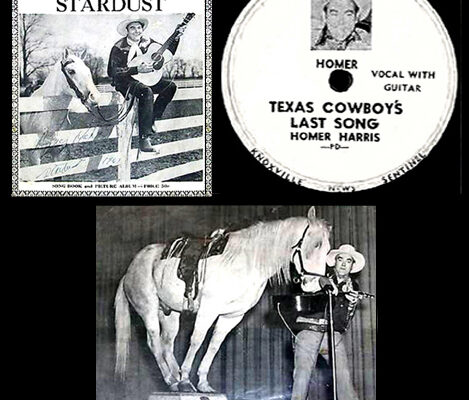Tommy Church, a Johnson City resident, recalled when Homer Harris, a local cowboy star, performed at his school:
“From 1971 until 1975, I attended kindergarten through the second grade at King Springs School. I remember when he and his trick horse, Stardust, came to our school and put on a program. I later attended Happy Valley Elementary School and he also visited there but with a horse that he called Stardust, Jr. Do you know anything about this man?”
Many East Tennessee residents who lived in the area from mid-1940 through the 1970s will likely recall Homer Harris and Stardust. He became known as the “Seven-Foot Smiling Cowboy,” but admitted that the figure also included his hat and boots. He became an instant hit with the area’s youthful “buckaroos and buckarettes.”
Harris was born on May 18, 1909 in Hartford, Tennessee in Cocke County. He acquired his first guitar while still a young boy and learned to sing by listening to old breakable 78-rpm phonograph records by country and western legends such as Mother Maybelle Carter.
In 1937, Homer acquired a job singing and playing his Martin guitar over WBIX in Muskogee, Oklahoma. While there, he won first prize in a radio contest singing, “Little Brown Jug.” A year later, the emerging songster moved to California where he displayed his talent in numerous venues. He was even hired to entertain Shirley Temple at her sixth birthday in Palm Springs.
Harris accepted a job at Monogram Studios in Hollywood doing supporting roles for western movies, but his employment was short-lived; he received his draft notice. While serving in the Army from 1942 to 1945, he participated in numerous GI shows. In 1943, the crooner made a guest shot singing “Little Brown Jug” in the British documentary film, “Welcome To Britain,” starring Bob Hope and Burgess Meredith. In April 1947, he recorded the song for Nation Record Company in New York, but apparently it was never released.
After his discharge from service, Harris used his separation pay to buy a Palomino horse that reportedly was named Prima. It would be the first of several steeds that he would own during his colorful career. He conceived the idea of writing a song that he titled, “I'm Riding My Horse on the Radio.” It became such a hit with youngsters that Homer decided to include his horse in his performances.
Soon after the war, Homer relocated to East Tennessee where he joined Knoxville’s “Mid-Day Merry-Go-Round” over WNOX. The program was comprised of Lowell Blanchard (program director, emcee); Archie “Grandpappy” Campbell (comedian, tenor, Hee Haw fame), Bill and Cliff Carlistle, Burke Barber, Molly O’Day and Homer Harris. In 1949, Homer began appearing on Cas Walker’s radio show over WROL and later WIVK. The savvy entrepreneur and philanthropist learned the financial benefits derived from using radio and later television to sponsor singers and musicians of old-time music to promote his chain of rustic supermarkets.

A photo from 1949 shows Harris sitting on his horse Dolly beside Cas inside one of his country stores. About this time, Homer purchased a 3-year-old trick horse named Stardust from Walker that added a new dimension to his act. The educated horse eventually learned to count by striking his foot on the ground and to strum Homer’s guitar using his nose. The popular cowboy began appearing on radio with three shows a day over Knoxville’s WROL (later renamed WATE). Soon after, a noon hour show was added for WIVK.
On July 16, 1950, Homer and Stardust participated in a remote broadcast sponsored by WIVK. Two 90-minute shows were presented at the Atomic Caverns (now Cherokee Caverns) located on the Oak Ridge Highway. The first show was aired from inside the caverns. At the conclusion, Stardust amazingly climbed 69 steps from 200 feet inside the caverns to the Crystal Ballroom at ground level. The second program followed outside at the caverns’ entrance. Admission for each was 75 cents for adults and 35 cents for children. Other entertainers included Hargis Kelly (trick fiddle), Simon Kelly (guitar), Pee Wee Whaley (mandolin), Puddin’ Head Joe (comedian) and the Kelly Brothers Quartet.
Subsequently, Homer and Stardust joined Bonnie Lou and Buster on WCYB radio. When WJHL television came on the air in 1953, the four of them moved to the new station where they performed with Lloyd Bell for a three-days-a-week program. Other musicians who performed with the group were Guy “Pepe” Pealer (steel guitar), Chuck Henderson (aka the Carolina Indian, guitar, banjo) and Bennie Sims (fiddler). Later, it became a daily morning show.
Homer eventually left WJHL and began touring the south with his guitar and famed trick horse. However in due time, he migrated back to Knoxville and joined Cas Walker again, this time appearing on the grocer’s music shows over WATE and WBIR television.
During the 1960s, the cowboy and his horse were busy appearing at area grammar schools and theatres. A July 3, 1969 theatre flyer promotes a 1965 movie and a western stage show with several music stars: “Showing on Screen- 'Buffalo Bill' – Ridin', Shootin', Singing TV Stars Coming In Person – Homer Harris, 7-Foot Cowboy; Carl Story, RCA Recording Star; Trick Horse, Stardust, A Real Live Oklahoma Educated Horse; Recording Stars: The Saddle Pals, Lloyd Bell and Bobby Thompson; and Ray Myers, The Armless Musician Who Leads a Normal Life.” The ad contained a photo of Homer and Stardust doing the “camel stretch.”
When Stardust passed away in 1973 at age 29, Homer had three-year-old Stardust, Jr. trained and ready to fill his hoofs. By 1978, Homer was forced to retire due to health reasons. Even then, the aging cowpoke occasionally performed at John Rice Irwin’s Museum of Appalachia near Norris, Tennessee and at local senior citizen centers and charity shows.
The end of the winding dusty trail for the towering “Seven-Foot Smiling Cowboy” came on September 7, 1998, concluding an entertainment career that is still fondly recalled by Tommy Church and many other area residents.

Comments are closed.